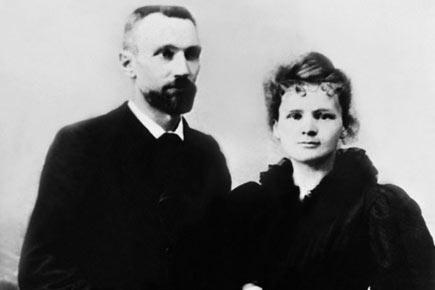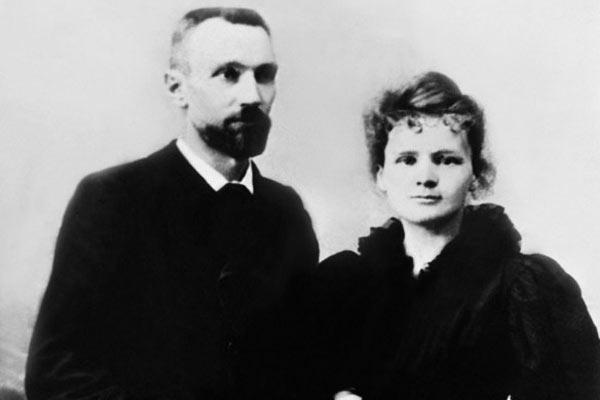Scientists Pierre Curie and wife Marie SkÅu00c2u0082odowska-Curie discovered the chemical element radium on this day, December 21 in 1898...

Scientists Pierre Curie and wife Marie SkÅu00c2u0082odowska-Curie discovered the chemical element radium on this day, December 21 in 1898. This discovery marked a significant development in scientific research. We take a look at how and what led to radium's discovery and the many contributions by the Curies in the field of science...
ADVERTISEMENT

Picture dated probably 1895 shows Marie Skolodowska Curie and husband Pierre Curie shortly after their wedding. Pic/AFP
Before stumbling upon radium the Curies discovered polonium, named after Marie Curie's native homeland Poland after separating an element similar to bismuth from pitchblende while studying an uraninite sample. This was possible after they removed uranium from the sample and found that the remaining material was still radioactive.
Pierre and Marie SkÅu00c2u0082odowska-Curie then further separated out a radioactive mixture consisting mostly of two components: compounds of barium, which gave a brilliant green flame color, and unknown radioactive compounds which gave carmine spectral lines that had never been documented before.
The Curies were able to separate out the radioactive compounds and discover the new element radium, since the radium compounds were similar to the barium compounds but were more insoluble.
The element was named radium after French word of the same name which is derived from the Latin term radius, meaning ray in recognition of radium's power of emitting energy in the form of rays. Pierre and Marie SkÅu00c2u0082odowska-Curie were therefore the first to coin the term 'radioactivity' in the course of their research. They officially announced their discovery to the French Academy of Sciences on 26 December 1898.
One of the most significant results of their joint research on radium was the discovery that diseased, tumor-forming cells were destroyed faster than healthy cells.
Pierre Curie and his older brother Jacques successfully demonstrated the electric potential of Piezoelectricity in 1880, an electric charge that accumulates when crystals are compressed. Combining their knowledge of pyroelectricity with their understanding of the underlying crystal structures that gave rise to pyroelectricity to predict crystal behavior, they demonstrated the effect using crystals of tourmaline, quartz, topaz, cane sugar, and Rochelle salt (sodium potassium tartrate tetrahydrate). Quartz and Rochelle salt exhibited the most piezoelectricity. Both brothers invented the Piezoelectric Quartz Electrometer to aid their work. Shortly afterwards, in 1881, they demonstrated the reverse effect: that crystals could be made to deform when subject to an electric field. Almost all digital electronic circuits now rely on this in the form of crystal oscillators.
Influenced by Wilhelm Roentgen's discovery of X-Rays in 1895 and Henri Becquerel's 1896 discovery of that uranium salts emitted rays that resembled X-rays in their penetrating power but unlike phosphorescence, did not depend on an external source of energy but seemed to arise spontaneously from uranium itself Marie Curie decided to look into uranium rays as a possible field of research for a thesis.
Marie Curie's innovative technique to investigate the samples was possible with the aid of a version of the electometer that was developed by her husband Pierre and his brother, a sensitive device for measuring electric charge years before her research began. Marie discovered that uranium rays caused the air around a sample to conduct electricity using Pierre's electometer and thus hypothesized that the radiation was not the outcome of some interaction of molecules but must come from the atom itself since the activity of the uranium compounds depended only on the quantity of uranium present. This hypothesis was instrumental in disproving the ancient assumption that atoms were indivisible.
Marie SkÅu00c2u0082odowska-Curie's research on radiology and X-Rays proved most helpful during the World War I. After seeing a need for field field radiological centres near the front lines to assist battlefield surgeons she procured X-ray equipment, vehicles, auxiliary generators, and developed mobile radiography units, which came to be popularly known as petites Curies ("Little Curies"). This was possible after a quick study of radiology, anatomy, and automotive mechanics.
Assisted at first by a military doctor and by her 17-year old daughter Irène, Curie directed the installation of 20 mobile radiological vehicles and another 200 radiological units at field hospitals in the first year of the war and later trained other women as aides. Marie became the director of the Red Cross Radiology Service and set up France's first military radiology centre, operational by late 1914.
In 1915 Curie produced hollow needles containing 'radium emanation', a colorless, radioactive gas given off by radium, later identified as radon, to be used for sterilizing infected tissue.[50] She provided the radium from her own one-gram supply.[50] It is estimated that over a million wounded soldiers were treated with her X-ray units. In spite of all her humanitarian contributions to the French war effort, Curie never received any formal recognition of it from the French government.
Pierre Curies studies on ferromagnetism, paramagnetism, and diamagnetism for his doctoral thesis led to the creation of Curie's Law after Curie discovered the effect of temperature on paramagnetism. The material constant in Curie's law is known as the Curie constant. Pierre Curie further discovered that ferromagnetic substances exhibited a critical temperature transition, above which the substances lost their ferromagnetic behavior. This is now known as the Curie point.
Pierre Curie formulated the Curie Dissymmetry Principle; a physical effect cannot have a dissymmetry absent from its efficient cause.
The curie is a unit of radioactivity (3.7 × 1010 decays per second or 37 gigabecquerels) originally named in honor of Curie by the Radiology Congress in 1910, after his death. Subsequently, there has been some controversy over whether the naming was in honor of Pierre, Marie, or both. Some sources say that Marie Curie named it in her husband's honour.
The first discovery of what would be known as nuclear energy was made by Pierre Curie and one of his students after identifying the continuous emission of heat from radium particles. He also investigated the radiation emissions of radioactive substances, and through the use of magnetic fields was able to show that some of the emissions were positively charged, some were negative and some were neutral. These correspond to alpha, beta and gamma radiation.
The Royal Swedish Academy of Sciences awarded Pierre Curie, Marie Curie, and Henri Becquerel the Nobel Prize in Physics in December 1903, "in recognition of the extraordinary services they have rendered by their joint researches on the radiation phenomena discovered by Professor Henri Becquerel."
This made Maria SkÅu00c2u0082odowska Curie the first woman to receive the Nobel Prize. At first, the Committee intended to honour only Pierre and Becquerel, but one of the committee members and an advocate of woman scientists, Swedish mathematician Magnus Goesta Mittag-Leffler, alerted Pierre to the situation, and after his complaint, Marie's name was added to the nomination.
Pierre and Maria SkÅu00c2u0082odowska Curie initially declined to go to Stockholm, Sweden to receive their Nobel Prizes due to their hectic research work and Pierre's dislike for public ceremonies. They finally undertook the trip in 1905 as Nobel laureates were required to deliver a lecture in person.
Marie Curie was the first woman to win a Nobel prize, the first person to win two Nobel Prizes, the only woman to win in two fields, and the only person to win in multiple sciences. Awards that she received include:
Nobel Prize in Physics (1903)
Davy Medal (1903, with Pierre)
Matteucci Medal (1904; with Pierre)
Actonian Prize (1907)
Elliott Cresson Medal (1909)
Nobel Prize in Chemistry (1911)
Soviet postage stamp (1987)
Franklin Medal of the American Philosophical Society (1921)
In 1995, she became the first woman to be entombed on her own merits in the Panthéon, Paris.
 Subscribe today by clicking the link and stay updated with the latest news!" Click here!
Subscribe today by clicking the link and stay updated with the latest news!" Click here!






